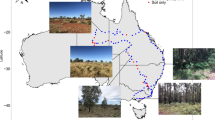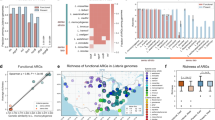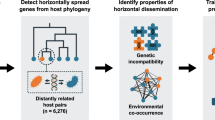Abstract
Soils harbor the most diverse naturally evolved antibiotic resistance genes (ARGs) on Earth, with implications for human health and ecosystem functioning. How ARGs evolve as soils develop over centuries, to millennia (i.e., pedogenesis), remains poorly understood, which introduces uncertainty in predictions of the dynamics of ARGs under changing environmental conditions. Here we investigated changes in the soil resistome by analyzing 16 globally distributed soil chronosequences, from centuries to millennia, spanning a wide range of ecosystem types and substrate age ranges. We show that ARG abundance and diversity decline only after millions of years of soil development as observed in very old chronosequences. Moreover, our data show increases in soil organic carbon content and microbial biomass as soil develops that were negatively correlated with the abundance and diversity of soil ARGs. This work reveals natural dynamics of soil ARGs during pedogenesis and suggests that such ecological patterns are predictable, which together advances our understanding of the environmental drivers of ARGs in terrestrial environments.
Similar content being viewed by others
Log in or create a free account to read this content
Gain free access to this article, as well as selected content from this journal and more on nature.com
or
References
Van Goethem MW, Pierneef R, Bezuidt OKI, Van De Peer Y, Cowan DA, Makhalanyane TP. A reservoir of ‘historical’ antibiotic resistance genes in remote pristine Antarctic soils. Microbiome. 2018;6:40.
D’Costa VM, McGrann KM, Hughes DW, Wright GD. Sampling the antibiotic resistome. Science. 2006;311:374–7.
Allen HK, Donato J, Wang HH, Cloud-Hansen KA, Davies J, Handelsman J. Call of the wild: antibiotic resistance genes in natural environments. Nat Rev Microbiol. 2010;8:251–9.
Martinez JL, Coque TM, Baquero F. What is a resistance gene? Ranking risk in resistomes. Nat Rev Microbiol. 2015;13:116–23.
Genilloud O. Actinomycetes: still a source of novel antibiotics. Nat Prod Rep. 2017;34:1203–32.
Ochoa-Hueso R, Plaza C, Moreno-Jimenez E, Delgado-Baquerizo M. Soil element coupling is driven by ecological context and atomic mass. Ecol Lett. 2021;24:319–26.
Wardle DA, Walker LR, Bardgett RD. Ecosystem properties and forest decline in contrasting long-term chronosequences. Science. 2004;305:509–13.
Crews TE, Kitayama K, Fownes JH, Riley RH, Herbert DA, Mueller-Dombois D, et al. Changes in soil phosphorus fractions and ecosystem dynamics across a long chronosequence in Hawaii. Ecology. 1995;76:1407–24.
Walker LR, Wardle DA, Bardgett RD, Clarkson BD. The use of chronosequences in studies of ecological succession and soil development. J Ecol. 2010;98:725–36.
Delgado-Baquerizo M, Reich PB, Bardgett RD, Eldridge DJ, Lambers H, Wardle DA, et al. The influence of soil age on ecosystem structure and function across biomes. Nat Commun. 2020;11:4721.
Andersson DI, Hughes D. Antibiotic resistance and its cost: is it possible to reverse resistance? Nat Rev Microbiol. 2010;8:260–71.
Zhu YG, Johnson TA, Su JQ, Qiao M, Guo GX, Stedtfeld RD, et al. Diverse and abundant antibiotic resistance genes in Chinese swine farms. Proc Natl Acad Sci USA. 2013;110:3435–40.
Zhu YG, Zhao Y, Li B, Huang CL, Zhang SY, Yu S, et al. Continental-scale pollution of estuaries with antibiotic resistance genes. Nat Microbiol. 2017;2:16270.
Li J, Cao J, Zhu YG, Chen QL, Shen F, Wu Y, et al. Global survey of antibiotic resistance genes in air. Environ Sci Technol. 2018;52:10975–84.
Delgado-Baquerizo M, Bardgett RD, Vitousek PM, Maestre FT, Williams MA, Eldridge DJ, et al. Changes in belowground biodiversity during ecosystem development. Proc Natl Acad Sci USA. 2019;116:6891–6.
Ortiz-Álvarez R, Fierer N, de Los Ríos A, Casamayor EO, Barberán A. Consistent changes in the taxonomic structure and functional attributes of bacterial communities during primary succession. ISME J. 2018;12:1658–67.
Shen J, Li Z-M, Hu H, Zeng J, Zhang L-M, He J, et al. Distribution and succession feature of antibiotic resistance genes along a soil development chronosequence in Urumqi No. 1 Glacier of China. Front Microbiol. 2019;10:1569.
Drenovsky RE, Vo D, Graham KJ, Scow KM. Soil water content and organic carbon availability are major determinants of soil microbial community composition. Micro Ecol. 2004;48:424–30.
Bastida F, Eldridge DJ, Garcia C, Kenny Png G, Bardgett RD, Delgado-Baquerizo M. Soil microbial diversity-biomass relationships are driven by soil carbon content across global biomes. ISME J. 2021;15:2081–91.
Acknowledgements
QL-C and HW-H thank the Australia Research Council (DP210100332, DE210100271) for the projects. We thank the researchers involved in the CLIMIFUN project for the help with soil sampling.
Funding
This project has received funding from the European Union’s Horizon 2020 research and innovation program under the Marie Sklodowska-Curie grant agreement no. 702057. MD-B is supported by a project from the Spanish Ministry of Science and Innovation (PID2020-115813RA-I00), and a project PAIDI 2020 from the Junta de Andalucía (P20_00879).
Author information
Authors and Affiliations
Contributions
QL-C, HW-H and MD-B conceived the idea of this study. MDB and HW-H conducted soil samplings and processing. QL-C conducted statistical analysis and modeling. The manuscript was written by QL-C, edited by HW-H and MD-B, and all co-authors contributed revisions.
Corresponding authors
Ethics declarations
Competing interests
The authors declare no competing interests.
Additional information
Publisher’s note Springer Nature remains neutral with regard to jurisdictional claims in published maps and institutional affiliations.
Supplementary information
Rights and permissions
About this article
Cite this article
Chen, QL., Hu, HW., Yan, ZZ. et al. Cross-biome antibiotic resistance decays after millions of years of soil development. ISME J 16, 1864–1867 (2022). https://doi.org/10.1038/s41396-022-01225-8
Received:
Revised:
Accepted:
Published:
Issue date:
DOI: https://doi.org/10.1038/s41396-022-01225-8
This article is cited by
-
Prevalence and dynamics of antimicrobial resistance in pioneer and developing Arctic soils
BMC Microbiology (2025)
-
Global soil antibiotic resistance genes are associated with increasing risk and connectivity to human resistome
Nature Communications (2025)
-
Geologically younger ecosystems are more dependent on soil biodiversity for supporting function
Nature Communications (2024)



